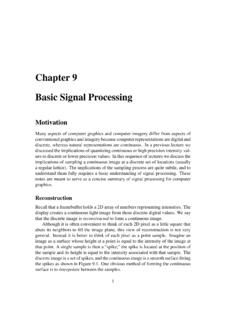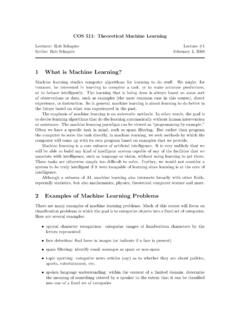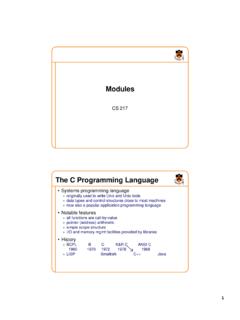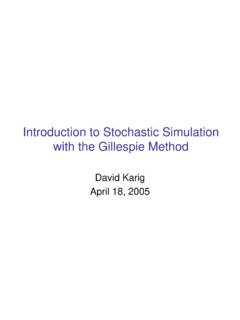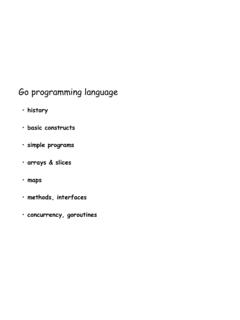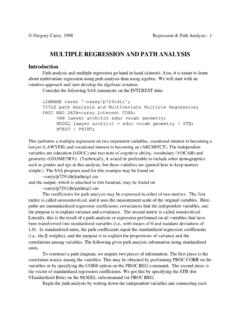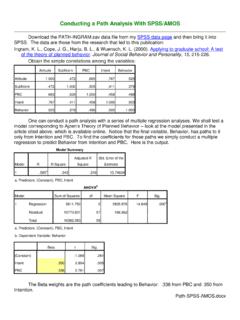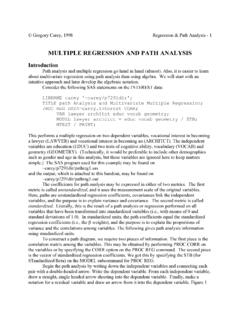Transcription of Finding Paths in Graphs
1 Finding Paths in GraphsRobert SedgewickPrinceton UniversityIntroductionMotivating exampleGrid graphsSearch methodsSmall world graphsConclusionSubtext: the scientific methodis necessary in algorithm design and implementationScientific method create a model describing natural world use model to develop hypotheses run experiments to validate hypotheses refine model and repeatAlgorithm designer who does not run experimentsrisks becoming lost in abstractionSoftware developer who ignores resource consumptionrisks catastrophic consequences Isolated theory or experiment can be of value when clearly identifiedmodelhypothesisexperimentIntro ductionIntroductionMotivating exampleGrid graphsSearch methodsSmall world graphsConclusionWarmup: random number generationProblem: write a program to generate random numbersmodel: classical probability and statisticshypothesis: frequency values should be uniform weak experiment: generate random numbers check for uniform frequenciesbetter experiment: generate random numbers use x2 test to check frequencyvalues against uniform distribution better hypotheses/experiments still needed many documented disasters active area of scientific research applications: simulation, cryptography connects to core issues in theory of computationV = 10random?
2 Modelhypothesisexperimentint k = 0;while ( true ) (k++ % V);int k = 0;while ( true ) { k = k*1664525 + 1013904223); (k % V);}0 1 2 3 4 5 6 7 8 9 0 1 2 3 4 5 6 7 ..textbook algorithm that flunks x2 test IntroductionIntroductionMotivating exampleGrid graphsSearch methodsSmall world graphsConclusionWarmup (continued)Q. Is a given sequence of numbers random?A. Does a given sequence exhibit some property that random number sequences exhibit?Birthday paradox Average count of random numbers generated until a duplicate happens is about pV/2 Example of a better experiment: generate numbers until duplicate check that count is close to pV/2 even better: repeat many times, check against distribution Anyone who considers arithmetical methods of producing random digits is, of course, in a state of sin John von NeumannV = 365average probesuntil duplicateis about 24 IntroductionIntroductionMotivating exampleGrid graphsSearch methodsSmall world graphsConclusionis a fundamental operation that demands understandingGround rules for this talk work in progress (more questions than answers) analysis of algorithms save deep dive for the right problemApplications graph -based optimization models networks percolation computer vision social networks (many more)
3 Basic research fundamental abstract operation with numerous applications worth doing even if no immediate application resist temptation to prematurely study impactFinding an st- path in a graphtsIntroductionIntroductionMotivatin g exampleGrid graphsSearch methodsSmall world graphsConclusionMotivating example: maxflowFord-Fulkerson maxflow scheme find any s-t path in a (residual) graph augment flow along path (may create or delete edges) iterate until no path existsGoal: compare performance of two basic implementations shortest augmenting path maximum capacity augmenting pathKey steps in analysis How many augmenting Paths ? What is the cost of Finding each path ?research literaturethis talkMotivating exampleIntroductionMotivating exampleGrid graphsSearch methodsSmall world graphsConclusionMotivating example: max flowCompare performance of Ford-Fulkerson implementations shortest augmenting path maximum-capacity augmenting pathGraph parameters number of vertices V number of edges E maximum capacity CHow many augmenting Paths ?
4 How many steps to find each path ? E (worst-case upper bound)worst case upper boundshortest VE/2 VCmax capacity2E lg CMotivating exampleIntroductionMotivating exampleGrid graphsSearch methodsSmall world graphsConclusionMotivating example: max flowCompare performance of Ford-Fulkerson implementations shortest augmenting path maximum-capacity augmenting pathGraph parameters for example graph number of vertices V = 177 number of edges E = 2000 maximum capacity C = 100 How many augmenting Paths ?How many steps to find each path ? 2000 (worst-case upper bound)worst case upper boundfor exampleshortest VE/2VC177,00017,700max capacity2E lg C 26,575 Motivating exampleIntroductionMotivating exampleGrid graphsSearch methodsSmall world graphsConclusionMotivating example: max flowCompare performance of Ford-Fulkerson implementations shortest augmenting path maximum-capacity augmenting pathGraph parameters for example graph number of vertices V = 177 number of edges E = 2000 maximum capacity C = 100 How many augmenting Paths ?
5 How many steps to find each path ? < 20, on averageworst case upper boundfor exampleactualshortest VE/2VC177,00017,70037max capacity2E lg C26,5757total is afactor of a million highfor thousand-node Graphs !Motivating exampleIntroductionMotivating exampleGrid graphsSearch methodsSmall world graphsConclusionMotivating example: max flowCompare performance of Ford-Fulkerson implementations shortest augmenting path maximum-capacity augmenting pathGraph parameters number of vertices V number of edges E maximum capacity CTotal number of steps?worst case upper boundshortest VE2/2 VECmax capacity2E2 lg CWARNING: The Algorithm Generalhas determined that using such results to predict performance or to compare algorithms may be exampleIntroductionMotivating exampleGrid graphsSearch methodsSmall world graphsConclusionGoals of algorithm analysis predict performance (running time) guarantee that cost is below specified boundsCommon wisdom random graph models are unrealistic average-case analysis of algorithms is too difficult worst-case performance bounds are the standardUnfortunate truth about worst-case bounds often useless for prediction (fictional) often useless for guarantee (too high) often misused to compare algorithmsBounds are useful in many applications:Open problem: Do better!
6 Motivating example: lessonsworst-case boundsactual costswhich ones??Motivating exampleIntroductionMotivating exampleGrid graphsSearch methodsSmall world graphsConclusionis a basic operation in a great many applicationsQ. What is the best way to find an st- path in a graph ?A. Several well-studied textbook algorithms are known Breadth-first search (BFS) finds the shortest path Depth-first search (DFS) is easy to implement Union-Find (UF) needs two passesBUT all three process all E edges in the worst case diverse kinds of Graphs are encountered in practiceWorst-case analysis is useless for predicting performanceWhich basic algorithm should a practitioner use? Finding an st- path in a graphts??IntroductionIntroductionMotivat ing exampleGrid graphsSearch methodsSmall world graphsConclusionGrid graphsAlgorithm performance depends on the graph modelInitial choice: grid Graphs sufficiently challenging to be interesting found in practice (or similar to Graphs found in practice) scalable potential for analysisGround rules algorithms should work for all Graphs algorithms should not use any special properties of the model.
7 (many appropriate candidates)ststcompleterandomgridneighbo rtsstsmall-worldtsif vertices have positions we can find short Paths quickly with A*(stay tuned)Grid graphsIntroductionMotivating exampleGrid graphsSearch methodsSmall world graphsConclusionExample 1: Statistical physics percolation model extensive simulations some analytic results arbitrarily huge graphsExample 2: Image processing model pixels in images maxflow/mincut energy minimization huge graphsApplications of grid graphsconductivityconcretegranular materialsporous mediapolymersforest firesepidemicsInternetresistor networksevolutionsocial influenceFermi paradoxfractal geometrystereo visionimage restorationobject segmentationscene graphsIntroductionMotivating exampleGrid graphsSearch methodsSmall world graphsConclusionLiterature on similar problemsPercolationRandom walkNonselfintersecting Paths in gridsGraph covering ??Which basic algorithm should a practitioner useto find a path in a grid-like graph ?
8 Grid graphsIntroductionMotivating exampleGrid graphsSearch methodsSmall world graphsConclusionM by M grid of verticesundirected edges connecting each vertex to its HV neighborssource vertex s at center of top boundary destination vertex t at center of bottom boundary Find any path connecting s to tCost measure: number of graph edges examinedFinding an st- path in a grid graphts M 2 verticesMverticesedges749841522542031961 1860633969781212716129320042556502512954 0511261121521220 about 2M 2 edgesGrid graphsIntroductionMotivating exampleGrid graphsSearch methodsSmall world graphsConclusionAbstract data typesseparate clients from implementationsA data type is a set of values and the operations performed on themAn abstract data type is a data type whose representation is hiddenImplementation should not be tailored to particular clientDevelop implementations that work properly for all clientsStudy their performance for the client at hand Interface Clients Implementationsinvoke operationsspecifies how to invoke opscode that implements opsSearch methodsIntroductionMotivating exampleGrid graphsSearch methodsSmall world graphsConclusionVertices are integers between 0 and V-1 Edges are vertex
9 PairsGraph ADT implements graph (Edge[]) to construct graph from array of edges findPath(int, int) to conduct search from s to t st(int) to return predecessor of v on path foundGraph abstract data typeint e = 0;Edge[] a = new Edge[E];for (int i = 0; i < V; i++) { if (i < V-M) a[e++] = new Edge(i, i+M); if (i >= M) a[e++] = new Edge(i, i-M); if ((i+1) % M != 0) a[e++] = new Edge(i, i+1); if (i % M != 0) a[e++] = new Edge(i, i-1); } graph G = new graph (a); (V-1-M/2, M/2);for (int k = t; k != s; k = (k)) (s + - + t);Example: client code for grid graphs0 1 2 3 45 6 7 8 910 11 12 13 1415 16 17 18 1920 21 22 23 24M = 5tsSearch methodsIntroductionMotivating exampleGrid graphsSearch methodsSmall world graphsConclusionDFS: standard implementationfor (int k = 0; k < E; k++) { int v = a[k].v, w = a[k].w; adj[v] = new Node(w, adj[v]); adj[w] = new Node(v, adj[w]); } graph ADT constructor codevoid findPathR(int s, int t) { if (s == t) return; visited(s) = true; for(Node x = adj[s]; x !)}
10 = null; x = ) if (!visited[ ]) searchR( , t); }void findPath(int s, int t) { visited = new boolean[V]; searchR(s, t); }DFS implementation (code to save path omitted)0 1 2 3 4 5 6 7 84774graph representationvertex-indexed array of linked lists two nodes per edgeSearch methodsIntroductionMotivating exampleGrid graphsSearch methodsSmall world graphsConclusioncost strongly depends on arbitrary decision in client code!Basic flaw in standard DFS (int i = 0; i < V; i++) { if ((i+1) % M != 0) a[e++] = new Edge(i, i+1); if (i % M != 0) a[e++] = new Edge(i, i-1); if (i < V-M) a[e++] = new Edge(i, i+M); if (i >= M) a[e++] = new Edge(i, i-M); }..west, east, north, southsouth, north, east, westorder of thesestatementsdeterminesorder in listsorder in listshas drastic effecton running timettss~E/2~E1/2bad newsfor ANYgraph modelSearch methodsIntroductionMotivating exampleGrid graphsSearch methodsSmall world graphsConclusionAddressing the basic flawAdvise the client to randomize the edges?
